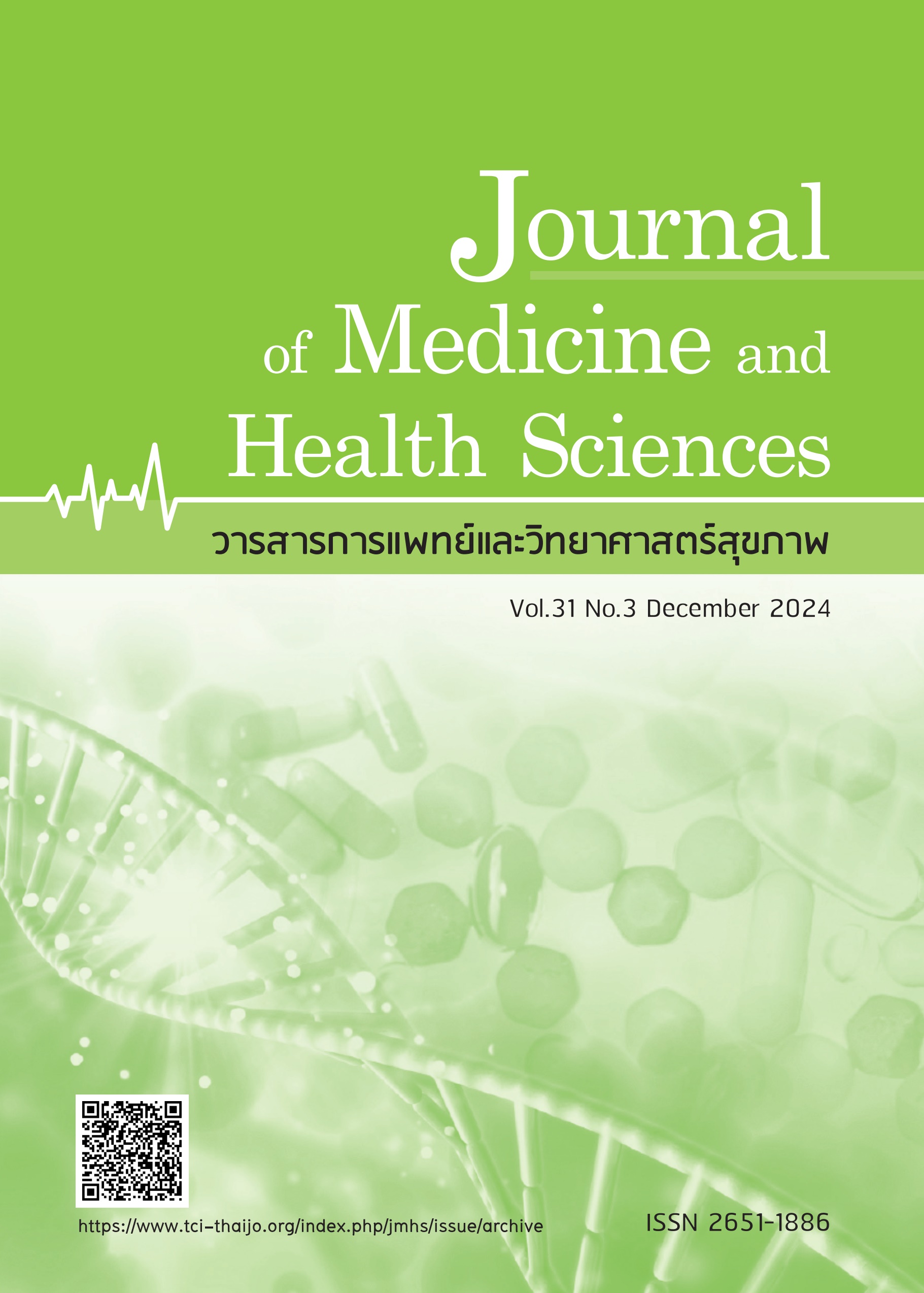Bleeding events in atrial fibrillation patients treated with Warfarin or NOACs at Chaiyaphum Hospital
Keywords:
โรคหัวใจเต้นผิดจังหวะ, การมีเลือดออก, ยาวาร์ฟาริน, NOACsAbstract
Atrial fibrillation (AF) is a common heart condition that increases the risk of blood clots, which can lead to stroke, heart attack, and death. Warfarin and Non-vitamin K antagonist oral anticoagulants (NOACs) are medications used to reduce this risk. However, concerns remain regarding the risk of bleeding complications associated with these drugs. This retrospective cohort study investigated the incidence of bleeding complications in patients with AF who were prescribed either Warfarin or NOACs. The study included 2,171 patients with AF who were treated between 2016 and 2023. Data were collected from electronic medical records and analyzed using survival analysis, Kaplan-Meier curves, incidence rate ratios, and incidence differences. Over an 8-year period (2016–2023), the proportions of Warfarin and NOAC use were 85.8% and 14.2%, respectively. The overall incidence of bleeding complications in the study population was 54.8%. The most common bleeding events were hematoma ecchymosis (2.6%) and gum bleeding (2.2%). The incidence of bleeding in the NOAC group was 1.9 per 100 person-years (95% confidence interval (CI) = 1.1-3.2), with no statistically significant difference in bleeding incidence between the two groups. Warfarin had a longer event-free survival time than NOACs (3.61 years; 95% CI = 2.90-4.33). Rivaroxaban, one of the NOACs, was associated with an increased risk of early bleeding. While NOACs had a slightly higher bleeding incidence than Warfarin, they were associated with less severe bleeding events. Warfarin was linked to a wider range of bleeding events, including gastrointestinal and intracranial hemorrhage. NOACs have a slightly higher incidence of bleeding complications than Warfarin, but they cause less severe bleeding events and a narrower range of bleeding types. Therefore, NOACs should be considered as an alternative to Warfarin for patients with a history of Warfarin use. Further research is needed to evaluate the safety and efficacy of individual NOACs, particularly rivaroxaban.
References
Calkins H, Hindricks G, Cappato R, et al. 2017 HRS/EHRA/ECAS/APHRS/SOLAECE expert consensus statement on catheter and surgical ablation of atrial fibrillation. Heart Rhythm 2017;14:e275-e444. doi:10.1016/j.hrthm.2017.05.012.
Odutayo A, Wong CX, Hsiao AJ, et al. Atrial fibrillation and risks of cardiovascular disease, renal disease, and death: Systematic review and meta-analysis. BMJ 2016;354:i4482. doi:10.1136/bmj.i4482.
Blomstrom Lundqvist C, Lip GY, Kirchhof P. What are the costs of atrial fibrillation? Europace 2011;13:ii9-12. doi:10.1093/europace/eur087.
Rahman F, Kwan GF, Benjamin EJ. Global epidemiology of atrial fibrillation. Nat Rev Cardiol 2014;11:639-54. doi:10.1038/nrcardio.2014.118.
Lim GB. Milestone 2: Warfarin: from rat poison to clinical use. Nat Rev Cardiol 2017. doi:10.1038/nrcardio.2017.172.
Steffel J, Verhamme P, Potpara TS, et al. The 2018 European Heart Rhythm Association Practical Guide on the use of non-vitamin K antagonist oral anticoagulants in patients with atrial fibrillation. Eur Heart J 2018;39:1330-93. doi:10.1093/eurheartj/ehy136.
Johnston S. An evidence summary of the management of patients taking direct oral anticoagulants (DOACs) undergoing dental surgery. Int J Oral Maxillofac Surg 2016;45:618-30. doi:10.1016/j.ijom.2015.12.010.
Eikelboom JW, Wallentin L, Connolly SJ, et. al. Risk of bleeding with 2 doses of dabigatran compared with warfarin in older and younger patients with atrial fibrillation: An analysis of the randomized evaluation of long-term anticoagulant therapy (RE-LY) trial. Circulation 2011;123:2363-72. doi:10.1161/CIRCULATIONAHA.110.004747.
Larsen TB, Skjøth F, Nielsen PB, et al. Comparative effectiveness and safety of non-vitamin K antagonist oral anticoagulants and warfarin in patients with atrial fibrillation: Propensity weighted nationwide cohort study. BMJ 2016;353:i3189. doi:10.1136/bmj.i3189.
Bengtson LGS, Lutsey PL, Chen LY, et al. Comparative effectiveness of dabigatran and rivaroxaban versus warfarin for the treatment of non-valvular atrial fibrillation. J Cardiol 2017;69:868-76. doi:10.1016/j.jjcc.2016.08.010.
Gómez-Outes A, Terleira-Fernández AI, Calvo-Rojas G, et al. Dabigatran, Rivaroxaban, or Apixaban versus Warfarin in patients with nonvalvular atrial fibrillation: A systematic review and metaanalysis of subgroups. Thrombosis 2013;2013:640723. doi:10.1155/2013/640723.
Nompannopas N. The oral anticoagulant use among ambulatory patients with nonvalvular atrial fibrillation at Sawanpracharak Hospital. R3 Med PHJ 2022;19:83-100. (in Thai).
Hfocus Online News Agency. In-depth health system analysis. Accessed April 22, 2024. Retrieved from https://www.hfocus.org/content/2022/09/25926.
Methavigul R, Methavigul K. Factors Influencing the quality of anticoagulation control in patients receiving combination therapy with Aspirin, Clopidogrel and Warfarin. J DMS 2017;42:59-65. (in Thai)
Schoenfeld DA. Sample-size formula for the proportional-hazards regression model. Biometrics 1983;39:499-503.
Adeboyeje G, Sylwestrzak G, Barron JJ, et.al. Major bleeding risk during anticoagulation with Warfarin, Dabigatran, Apixaban, or Rivaroxaban in patients with nonvalvular atrial fibrillation. J Manag Care Spec Pharm 2017;23:968-78. doi:10.18553/jmcp.2017.23.9.968.
The Heart Association of Thailand under the Royal Patronage. Guidelines for the treatment of patients with oral anticoagulants. Accessed March 23, 2024, Retrieved from http://www.thaiheart.org/ index.php?lay=show&ac=article&Id=539252670&Ntype=5.
Piersma FR, Breel JS, Krul SPJ, et al. Atrial fibrillation: A retrospective chart review of mcomplications, morbidity and mortality at 30 days. Eur Heart J 2022;43:ehac544.2750. doi:10.1093/eurheartj/ehac544.2750.
du Fay de Lavallaz J, Badertscher P, Ghannam M, et al. Severe periprocedural complications after ablation for atrial fibrillation: An international collaborative individual patient data registry. JACC Clin Electrophysiol 2024;10:1353-64. doi:10.1016/j.jacep.2024.03.024.
Srivastava Y, Almader-Douglas D, Dero S, et al. Stroke risk with Warfarin vs. NOACs in artificial heart valves: A meta-analysis. Neurology 2023;100:edsbas.155FDA45. doi:10.1212/WNL.0000000000202880.
Patel SM, Braunwald E, Steffel J, et al. Efficacy and safety of non-vitamin-K antagonist oral anticoagulants versus Warfarin across the spectrum of body mass index and body weight: An individual patient data meta-analysis of 4 randomized clinical trials of patients with atrial fibrillation. Circulation 2024;149:932-43. doi:10.1161/CIRCULATIONAHA.123.066279.
Lee HF, See LC, Li PR, et al. Non-vitamin K antagonist oral anticoagulants and Warfarin in atrial fibrillation patients with concomitant peripheral artery disease. Eur Heart J Cardiovasc Pharmacother 2021;7:50-8. doi:10.1093/ehjcvp/pvz072.
Dogan Y, Az A, Sogut O, et al. Bleeding events in the emergency department with warfarin versus novel oral anticoagulants: A five-year analysis. Niger J Clin Pract 2022;25:1308-17. doi:10.4103/njcp.njcp_125_22.
Downloads
Published
How to Cite
Issue
Section
License
Copyright (c) 2024 Journal of Medicine and Health Sciences

This work is licensed under a Creative Commons Attribution-NonCommercial-NoDerivatives 4.0 International License.





